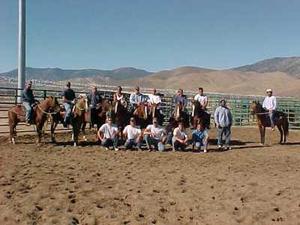Border securityInmate-trained wild horses help secure U.S. border
Border patrol agents have a new ally in the fight to secure the U.S-Mexico border – specially trained horses – and it is all thanks to prison inmates

A group of inmates with some of the mustangs they've trained // Source: kbrhorse.net
Border patrol agents have a new ally in the fight to secure the U.S-Mexico border – specially trained horses – and it is all thanks to prison inmates.
Beginning in 2007 the U.S. Border Patrol struck a partnership with prisons in Colorado to train wild horses caught on public land by Bureau of Land Management contractors. So far the program has trained 130 mustangs that have helped border patrol agents navigate the rugged terrain along the southwestern border that is often inaccessible by car.
In addition the horses’ natural instincts and senses provide border patrol agents with a unique edge. During a recent night patrol along the Rio Grande portion of the southwestern border, two mounted agents helped capture twenty-one immigrants illegally attempting to cross the border out of a group of thirty.
Agent Audra Wannemacher, one of the mounted agents who participated in the patrol, said, “The horses could smell [the group of immigrants] before we could see them. And with their hearing, they can pick up the noises before we can. They kind of alert to it. Now that they’ve been out there for a few months, they’re picking up on what they’re here to do. It’s very helpful to have those heightened senses of the horses.”
Supervisory Border Patrol Agent Mary Olivares of the Rio Grande section added that the horses have proven to be a fearsome asset during patrols.
“They make a huge psychological impact. Huge. All you can hear is this thunderous sound behind you. All you hear is hooves. They’re pretty scary,” Olivares said.
Since October eleven mustangs have been deployed along the Rio Grande, and in those two months, mounted agents have arrested 784 people attempting to cross the border and seized more than 6,000 pounds of marijuana.
Aside from just helping border patrol agents perform their duties, Paul McGuire, who helps coordinate the mustang training program between the Bureau of Land Management and the Border Patrol, said the program also helps preserves nature and provides inmates with a valuable rehabilitative opportunity.
“We’re not only working to preserve mustangs as valued icons of the American West and providing Border Patrol with a very useful tool to secure the border, but also providing a program that helps with inmates’ introduction back into society,” McGuire said.
The Hutchinson Correctional Facility in Kansas, which supplied the Rio Grande patrol sector with its eleven mustangs, has an agreement with border patrol to pasture roughly 300 wild horses that are at least five years old.
According to Dexter Hedrick, the prison’s wild horse training program manager, Hutchinson has about twenty wild horses at any given time being trained by inmates who qualify.
Hedrick explained that inmates use a very gentle training technique to teach the horses basic maneuvers like how to stop, back up, or walk sideways.
“It’s good for the [inmates], and it’s good for the public,” Hedrick said. “Horses are very smart animals. They will alert the agent to the movement of people before the agents can see it. They’re actually doing the agents’ jobs in a lot of ways.”
The bureau funds the program at Hutchinson, providing $3.40 per horse per day, or about $372,300 annually, while each inmate trainer makes between 25 cents to 60 cents per hour, with the occasional rider making as much as $3 an hour. In contrast, the highest pay for most jobs at Hutchinson is $1.05 per day.
Meanwhile at the Rio Grande border unit, Olivares is more than pleased with the horses’ performance as well as the Hutchinson training program.
“We’ve gotten eleven so far, and we wouldn’t even consider taking one back,” Olivares said. “If I go to pick up a horse from someone locally, you don’t know what training they’ve had. With these, I know their foundation. I know where they were started. And I know who did the job and I know they do a fantastic job.”
